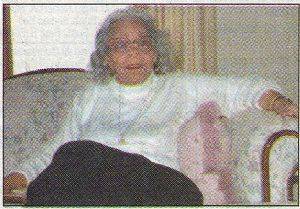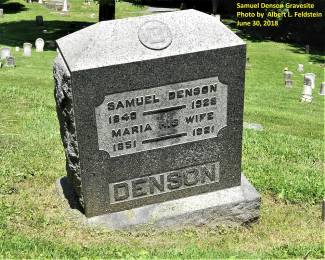Collection Name
About
Underground Railroad history
City woman recalls grandfather's role
MARIA D. MARTIRANO
FEBRUARY 9, 2004
CUMBERLAND —
As a child walking home from Frederick Street School, Romaine Franklin would stop by to see her grandfather, who gave her a coin each time.
She'd ask how he was doing, and he would respond "just tolerable." Then he asked which grandchild she was. And once she answered, he'd give her a nickel or a dime.
"I was one of his spoiled grandchildren," she said.
It wasn't until later in life that Franklin realized her grandfather, Samuel Denson, may have helped lead an unknown number of slaves escape to freedom.
While some of the details of Denson's life are sketchy, Franklin knows her grandfather was born in 1840 and was a runaway slave from Vicksburg, Miss. The son of a slave and the "owner of the Big House," Denson was a slave in the house, which is where he learned to read and write.
He arrived in Cumberland during the Civil War — probably in the early 1860s — although it was never discussed why or how he escaped from Mississippi to the Queen City.
Once here, he became a sexton at Emmanuel Episcopal Church on Washington Street.
The church is believed to be part of the Underground Railroad that was in operation from 1820 to 1865. Slaves were alerted to the safe passage through a quilt pattern that showed a pile of blocks under two bells.
Slaves knew it was safe to come to the church when they heard the double ring of the bell. Many believe Denson was one of the ringers. The information is part of what is being used to apply for the church to become a site on the Underground Railroad Network to Freedom.
Franklin, 87, of Greene Street, said she doesn't have any "direct proof" that her grandfather rang the church bell, but the pieces she does know make it logical that he was an integral part of the system.
In 1868, Denson married Mariah Johnson. The two had 12 children, including Franklin's father, Charles.
Segregation still was prevalent and the Denson family attended Emmanuel where they worshiped from a balcony. Franklin's grandfather started a Sunday school for the black families and their children.
In 1891, when Emmanuel underwent renovations and removed the balcony, property was purchased at the intersection of Baltimore and Greene streets where St. Philip's, the black Episcopalian church, was constructed. Denson was instrumental in establishing the church and served as a leader. The church later moved to Smallwood Street before it closed in 1960.
Franklin said she's not sure how many years her grandfather worked at the church but it was long enough that he saved enough money to open his own barbershop on Mechanic Street, across from the Public Safety Building. He also opened a pool room behind it.
The three-story building housed the businesses on the ground floor and the Densons' living quarters on the upper stories.
Franklin said it makes her proud that her grandfather may have helped so many people, but she believes the story of the railroad has been "lost and forgotten."
She is doing her part to keep the story alive and has shared the family tale with her son and other relatives. Several others, including representatives of the Maryland African American Museum of History and Culture, which is slated to open in the fall in Baltimore, have called upon her for information.
Underground Railroad history
CUMBERLAND — Raymond Dobard "literally sucked in his breath" when he saw Emmanuel Episcopal Church, for he knew it had served as a site along the Underground Railroad.
His reaction confirmed what Stephanie Gates and the Rev. Ed Chapman, pastor at Emmanuel, had believed for some time.
It also lends credence for the site to become part of the Underground Railroad Network to Freedom.
Gates, a local Underground Railroad historian, calls the story of the system that operated from 1820 to 1865 "inspirational."
"I think it's important because everyone, at one time in their life, feels downtrodden and begins to lose hope that they're on the right path and doesn't know clearly what they should do," Gates said.
"Everyone at every level, no matter how bad the circumstances or the situation, can see there is hope. And if you are willing to help yourself, there are people to help you. It's a story of self-help, community help and hope. It needs to be shouted from the rooftops," she said. She also is confident this area's story soon will become part of the network.
"It's important we get the designation because it then authenticates Cumberland's important role in that period of history," Gates, a native of Cumberland, said.
Chapman agrees and said it is "tremendously important."
"It's a story that is only now unfolding," he said. "There's a very significant social history to it... This means so much to so many people."
The local application, which was submitted about one year ago, is pending. It was a difficult process because as a "secret spy network," no one kept records. Those found helping slaves escape could be put to death and certainly were sent to prison, Gates said.
"The Underground Railroad was a vast conspiracy of people of good will who were trying to right a terrible wrong," Chapman said.
Before they could apply to become part of the network they needed solid information. It helped to learn that Cumberland resident Romaine Franklin's grandfather Samuel Denson possibly rang the church bell to alert slaves it was OK to come to Emmanuel. Also, a priest here was known to have been involved in the railroad in other places.
The application became stronger when Dobard attended CanalFest in 2000. He coauthored Hidden in Plain View, which describes how quilt patterns held cryptic messages that led slaves along the railroad.
When Chapman met Dobard, he described Emmanuel "perfectly," Gates said.
Gates cites the city as an employment center and a transportation hub that was essential for the railroad, with the C&O Canal, B&O Railroad and National Road all located here. The area's proximity to Pennsylvania, which meant freedom, also makes a strong case.
Gates looks at the canal boats in particular and said those could serve as a place for runaway slaves to be stowaways. Many also walked the Potomac River and ended up in Ridgeley. Those who escaped to this area also could blend in easily —especially in the seedier parts of town where winos and prostitutes were prevalent.
"Nobody went there, or if they did, they didn't want to admit it," she said. "And they did not pay attention to who was there."
But if the local site receives designation as part of the freedom network, it already will become part of an endangered list.
The network has been named to America's 10 Most Endangered National Parks, which is distributed by the National Parks Conservation Association, a park advocacy organization.
It ranks eighth on the endangered list because of "insufficient daily operating funds." Other endangered parks include Big Thicket National Preserve in Tennessee, which ranks first, and Yellowstone National Park, at No. 10.
"It's absolutely vital that we get a groundswell of public opinion," Alan Spears, the association's associate director of diversity, said of the network.
Spears said the network that started in 1998 through legislation is active in 28 states as well as Washington, D.C. and the Virgin Islands. So far, 149 sites have been identified. Once accepted, the groups are eligible to receive grant money that could help them develop their stories.
He said a "modest" $1.5 million increase from last year's $491,000 has been requested for the network, which "doesn't even cover basic salaries."
He encouraged citizens to send letters to their congressmen asking for their support.
It should be noted that research undertaken in recent years by Dan Whetzel and other historians call into question the accuracy of the historical accounts, timing and relationship among Samuel Denson, the Underground Railroad and Emmanuel Episcopal Church. As always, and without real documentation, this should be considered within the context of the oral history and folklore as it has been passed down to this time. We have posted some of this recent research elsewhere on this website.
Photograph of Romaine Franklin taken by Wesley Haines of Cumberland Times-News
Romaine Franklin was born in 1917 and passed away in 2016 at 99 years of age.

